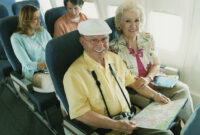Senior travel groups offer a unique and enriching experience, catering to the specific needs and desires of older adults. These groups provide a structured and supportive environment for exploration, relaxation, and social interaction, allowing seniors to travel with confidence and ease. Whether seeking adventurous excursions or tranquil retreats, diverse options exist to suit various preferences and activity levels. This exploration delves into the planning, logistics, marketing, and social dynamics involved in creating successful and fulfilling senior travel experiences.
From meticulously planned itineraries to comprehensive health and safety protocols, the organization and execution of senior travel groups require careful consideration. Understanding the target demographic, effectively marketing these experiences, and addressing the unique challenges and rewards of group travel are all crucial components of success. This detailed examination will cover various aspects, ensuring a well-rounded understanding of this growing sector of the travel industry.
Accessibility and Inclusivity
Creating truly memorable travel experiences for senior groups necessitates a proactive and comprehensive approach to accessibility and inclusivity. Failing to consider the diverse physical abilities and needs within the group can lead to exclusion and diminish the overall enjoyment of the trip. This section details strategies to ensure that all participants, regardless of their physical limitations, feel welcome, comfortable, and fully involved.
Ensuring accessible and inclusive travel for seniors requires careful planning and consideration across all aspects of the trip. This includes pre-trip communication, transportation arrangements, accommodation choices, and activity selection. A well-structured itinerary that incorporates diverse interests and caters to varied physical abilities will foster a positive and enriching experience for everyone.
Accessibility Checklist for Senior Travel Groups
Prioritizing accessibility begins long before the departure date. Thorough pre-planning and attention to detail are crucial for creating a smooth and enjoyable experience for all participants. The following checklist highlights key considerations:
- Transportation: Confirm that all transportation options (buses, trains, airplanes) are accessible, with features such as ramps, wide aisles, and accessible restrooms. Consider providing assistance with luggage and boarding where needed. For example, booking a flight with a wheelchair assistance service and reserving accessible seating on the bus.
- Accommodation: Select hotels and other accommodations with accessible rooms featuring features like roll-in showers, grab bars, and adequate space for wheelchairs or mobility aids. Confirm the availability of elevators and accessible routes throughout the building. For example, a hotel room with a lowered countertop and adjustable showerhead.
- Activities and Excursions: Choose activities and excursions that are suitable for varying levels of physical ability. Offer alternative options for those who may not be able to participate in more strenuous activities. For instance, provide a guided walking tour with rest stops and options for shorter routes, alongside a guided bus tour of the same locations.
- Communication: Provide clear and concise information about the itinerary, including details on accessibility features at each location. Use large print materials and offer alternative formats such as audio recordings or Braille for those with visual impairments. For example, provide itinerary information in multiple formats, including large print, audio, and digital versions.
- Support Staff: Consider hiring support staff such as trained medical personnel or assistants who can provide assistance to those with specific needs. This may include help with mobility, medication management, or other personal care requirements. For example, a trained nurse or physical therapist to accompany the group on longer excursions.
- Emergency Preparedness: Develop a comprehensive emergency plan that addresses the specific needs of individuals with disabilities. This includes identifying accessible evacuation routes and having appropriate communication systems in place. For instance, providing emergency contact information in large print and multiple languages.
Incorporating Diverse Perspectives and Interests
A successful senior travel experience embraces the diverse interests and preferences of the participants. It’s crucial to move beyond a one-size-fits-all approach and create an itinerary that caters to a wide range of abilities and desires.
- Pre-Trip Surveys: Conduct pre-trip surveys to gather information about participants’ interests, physical abilities, and any specific needs or preferences. This allows for personalized itinerary planning and ensures everyone feels heard and included. For example, a survey could include questions about preferred activity levels, dietary restrictions, and preferred communication methods.
- Flexible Itinerary: Design a flexible itinerary that allows for adjustments based on the group’s needs and preferences. Include options for free time and allow participants to choose activities that align with their interests and physical capabilities. For example, allowing for optional activities like leisurely walks, museum visits, or relaxing spa treatments.
- Diverse Activities: Offer a variety of activities to cater to diverse interests. This could include historical tours, cultural experiences, nature walks, cooking classes, or art workshops. For example, a trip could include both a challenging hike and a relaxing wine tasting experience.
- Peer Support: Encourage peer support and interaction among group members. This fosters a sense of community and allows participants to share experiences and support one another. For example, creating opportunities for group meals and informal gatherings.
Cost and Budget Considerations
Planning a senior travel group trip requires careful consideration of various costs to ensure a financially responsible and enjoyable experience for all participants. Understanding these costs upfront allows for transparent budgeting and prevents unexpected financial burdens. This section details typical expenses and strategies for cost optimization.
Typical Costs Associated with Senior Travel Group Trips
Several key expense categories contribute to the overall cost of a senior travel group trip. These include transportation (airfare, ground transportation, airport transfers), accommodation (hotel rooms, cruise cabins), activities and excursions (guided tours, entrance fees, entertainment), meals (breakfast, lunch, dinner), travel insurance, and miscellaneous expenses (tips, souvenirs, personal spending money). The specific cost of each category varies greatly depending on factors such as destination, travel dates, group size, and the level of luxury desired. For example, a trip to Europe will naturally be more expensive than a domestic trip to a nearby state. A trip during peak season will also be more expensive than an off-season trip.
Cost-Saving Strategies for Senior Travel Groups
Several strategies can help reduce the overall cost of a senior travel group trip. Booking flights and accommodations well in advance often secures lower prices. Traveling during the shoulder season (the period between peak and off-season) can also lead to significant savings on flights and accommodation. Choosing budget-friendly accommodation options, such as hostels or guesthouses instead of luxury hotels, can also help reduce costs. Similarly, opting for group discounts on activities and excursions can be beneficial. Careful planning of meals, perhaps incorporating self-catering options where feasible, can further contribute to cost savings. Finally, exploring free or low-cost activities in the destination can add value without impacting the budget significantly. For instance, walking tours or exploring local parks can be enriching alternatives to expensive paid excursions.
Pricing Models for Senior Travel Groups
Senior travel groups often utilize different pricing models to cater to diverse budgetary needs and preferences. An all-inclusive package typically bundles together transportation, accommodation, meals, and most activities into one price. This simplifies budgeting for participants but may not offer the flexibility to customize the trip according to individual preferences. In contrast, an a la carte model allows participants to choose and pay for individual components of the trip, offering greater flexibility but potentially leading to higher overall costs if not managed carefully. A hybrid approach, combining elements of both models, could also be considered, offering a base package with options to add additional activities or upgrades as desired.
Value Proposition of Different Travel Group Packages
The value proposition of a travel group package is determined by the balance between price and the services included. An all-inclusive package offers convenience and predictability, making it ideal for those who prefer a hassle-free travel experience. However, it may not be the most cost-effective option if participants have specific preferences that are not included in the package. An a la carte model offers greater flexibility and potentially lower costs if carefully planned, but it requires more active involvement from participants in selecting and booking individual components. The best package depends on the group’s priorities, budget, and the level of customization desired. For example, a group prioritizing relaxation and minimal planning might opt for an all-inclusive package, while a group with diverse interests might prefer an a la carte model to tailor their experiences.
Health and Safety Protocols
Prioritizing the well-being of our senior travelers is paramount. This section details the comprehensive health and safety protocols implemented to ensure a secure and enjoyable travel experience for everyone. We understand that health concerns and potential emergencies can arise, and our proactive approach aims to mitigate risks and provide swift, effective responses.
Emergency Preparedness Plans
A detailed emergency preparedness plan is crucial for any senior travel group. This plan outlines procedures for various scenarios, including medical emergencies, natural disasters, and security incidents. The plan includes pre-trip briefings for participants, clearly outlining emergency contact information, meeting points, and procedures for reporting incidents. Designated team members will receive specialized training in first aid and CPR, and the group will carry a well-stocked first-aid kit containing essential medications and supplies. Furthermore, we maintain 24/7 contact with local emergency services and have established communication protocols to ensure rapid response times in case of need. For example, in the event of a medical emergency, a designated team member will immediately contact emergency services, while another will remain with the affected individual, providing support and comfort until medical assistance arrives. Our plan also details procedures for evacuations, including transportation arrangements and communication strategies to keep participants informed throughout the process.
Travel Insurance Options and Importance for Senior Travelers
Travel insurance is not merely an optional add-on; it is an essential component of responsible senior travel planning. Comprehensive travel insurance policies protect against unforeseen circumstances, including medical emergencies, trip cancellations, and lost luggage. Policies should specifically address the needs of senior travelers, offering higher coverage limits for medical expenses and potentially including pre-existing condition coverage. We recommend reviewing policy details carefully, paying attention to coverage amounts, exclusions, and claim procedures. For instance, a policy might cover emergency medical evacuation, which can be particularly crucial for seniors traveling internationally or to remote locations. The peace of mind afforded by adequate insurance allows seniors to focus on enjoying their trip, knowing that they are financially protected in the event of unexpected events. Failure to secure appropriate travel insurance can result in significant financial burdens in case of an emergency.
Health and Safety Guide for Senior Travel Group Leaders
A comprehensive guide for group leaders is essential for effective health and safety management. This guide provides detailed instructions on pre-trip preparation, including reviewing participant health profiles, ensuring appropriate medication is available, and verifying emergency contact information. During the trip, the guide outlines procedures for daily health checks, managing minor illnesses, and responding to emergencies. It includes checklists for daily safety procedures, such as confirming transportation arrangements, reviewing itinerary details, and ensuring participant awareness of local safety guidelines. The guide also emphasizes the importance of clear communication with participants and maintaining a supportive and inclusive environment. Regular communication with the travel agency and emergency contacts is also stressed. For example, the guide would include a detailed protocol for managing a fall or a sudden illness, including steps for administering first aid, contacting emergency services, and notifying family members. Furthermore, it will provide a step-by-step guide on how to handle lost or stolen belongings.
Closing Notes
Ultimately, the success of senior travel groups hinges on a thoughtful blend of meticulous planning, engaging activities, and a focus on the well-being and enjoyment of participants. By addressing the unique needs and preferences of older adults, and fostering a sense of community and shared experience, these groups offer invaluable opportunities for adventure, relaxation, and lasting memories. Careful consideration of logistics, marketing strategies, and group dynamics ensures a positive and enriching travel experience for all involved, solidifying the value and appeal of senior travel groups.




